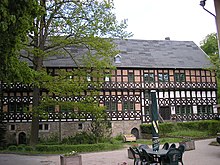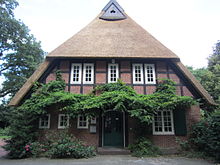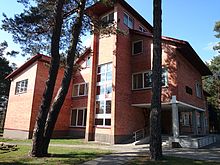Forestry Office



The forest office is a forest authority or an administrative unit that is responsible for looking after certain forest areas. As a result of privatization measures , many forest offices have now become forest administrations, thus former authorities outsourced as business operations.
tasks
The main tasks of the forest offices are the management of the property and the management of the forest from an economic point of view. This includes the production, harvest and marketing of wood and by-products as well as game and, on the same area, ensuring the special protective and recreational functions of the forest. Under appropriate ownership to forestry offices subordinate to the hunting law .
In some German federal states, the state forest offices also take care of private forests. This takes place in so-called standardized forest offices.
Designations
The name of a forest office can vary depending on the state, region and type of ownership. In more general terms, one speaks of forest management , which also includes the comparable institutions of large private forests .
- Forestry offices in the Federal Republic of Germany Federal forestry offices, state forestry offices, municipal forestry offices, private forestry offices or support forestry offices. They are usually divided into district foresters , also called operating districts.
- In Saxony-Anhalt the official name is the forest care office, for private and corporate forests, in the state forest it is forest operations.
- In Schleswig-Holstein the official name is forestry . The operating districts usually comprise the boundaries of individual villages or cities and city districts or the areas of several villages in a "network". In Thuringia , the entire state area is divided into state forest office districts by the highest forest authority in accordance with Section 59 of the State Forest Act and these are divided into forest management districts (forest districts). In some regions, the municipal forest offices are headed by the forestry directorate at the level of each administrative district . Some of the German federal states also have a forestry establishment at state level .
- In Austria, the former forestry offices are called Bezirksforstinspektion (BFI), which is headed by a regional forestry directorate at the level of each federal state . Forest institutes , on the other hand, are teaching and research institutions.
- In most parts of Switzerland it is the so-called district forest offices in the municipalities . A cantonal forestry office is assigned to them.
Prussia
In Prussia , the name Oberförsterei was common. In the Prussian period after 1815 ( Congress of Vienna ) the forest administration was reorganized. The municipalities could join a neighboring Royal Chief Forester or set up their own Communal Chief Forester . To this day, only the Willebadessen Community Forestry Office , a municipal forestry office, has almost the same composition of this organizational structure .
In the past, the heads of the forest office were also called chief forester or forester . The latter is not to be confused with the current name for forest manager .
Germany

The vast majority of the forest offices in Germany are authorities of the state forest administrations and are primarily responsible for the state forest, also known as the state forest . As supervisory forest offices , they often take on the management of corporate and private forests.
Federal forest offices manage forests owned by the Federal Republic of Germany. These are often military training areas or other military properties .
to form
Many German municipalities also own forests and have municipal forest offices .
There are forest offices of the chambers of agriculture in various German federal states . These are for the advice and support of the private forest responsible mainly farms - not if these mandatory task of Chambers of Agriculture by favored by Federal Forest Act, directly forest rural self-government in the form of forest plant communities is perceived. Only a few forest owners have enough forest to be able to afford a private forest office. The monastery forest offices of the monastery chamber Hanover in Lower Saxony are a specialty .
Austria
In Austria, the republic's forest holdings were outsourced from public administration and relocated to Österreichische Bundesforste AG, which means that all forest offices have become operational sites. The designation "Forest Office" refers to the company name of forest operations as part of the name. In the context of the city administration, it is about a municipal department (for example, forestry office and agricultural enterprise of the city of Vienna ). In Austria, 15 forestry operations are available as regional contacts for hunting, fishing, real estate and services. The company is divided into twelve forestry operations , two national park operations ( Kalkalpen and Donau-Auen ) and one forest technology operation. Each forest enterprise is divided into forest districts . The forest area is managed by a district manager. The general management was in Vienna , now the company management is in Purkersdorf .
Austria also has a high proportion of private forest , which is unique in Europe, of former, aristocratic large estates, as well as church forests of monasteries, which also have their own forest administrations.
Lithuania
The head forester's office (lit. miškų urėdija ) is a state enterprise in Lithuania , responsible for forest management and forest protection . It is headed by a chief forester (lit. miškų urėdas ). There are 42 chief forester's offices in Lithuania. They are subordinate to the General Forestry Office at the Ministry of the Environment of Lithuania . The general forest manager ( generalinis miškų urėdas ) is the chief forest officer in the forestry sector in Lithuania .
The Lithuanian chief forestry authorities manage 1.060 million hectares of state forest (2014). The average head forestry size is 25,200 hectares. The largest are in Švenčionėliai (43,000 ha), Panevėžys (40,000 ha), Ukmergė (37,300 ha), Kretinga (35,400 ha), Telšiai (35,100 ha) and Šilutė (34,300 ha), the smallest in Dubrava , Kupiškis and Zarasai (the The size of the managed state forests is less than 15,000 ha).
The chief foresters' offices in Lithuania are divided into forestry departments ( girininkija ). In 2013 the average forestry size was 3,045 hectares (3,300 hectares in 2004). There are 4,200 employees in the Lithuanian chief forestry officers. In 2015 Seimas tried to anchor the number of chief foresters in law. Only a veto by President Dalia Grybauskaitė prevented the new Lithuanian forest law from coming into force.
literature
- Karl Hasel , Ekkehard Schwartz : Forest history. A floor plan for study and practice . Kessel, Remagen 2002, ISBN 3-935638-26-4
Web links
Individual evidence
- ↑ https://www.bundesimmobilien.de/7627746/forstliche-produkte#
- ↑ § 59 Thuringian Forest Act in the version of June 24, 2008, online
- ^ Structure of the community forestry office Willebadessen
- ↑ Structure ( Austrian Federal Forests )
- ^ Forest districts in Austria
- ↑ Statistics 2013 ( Memento from February 21, 2016 in the Internet Archive ) ( Forest in Lithuania )
- ↑ Visuotinis girininkų suvažiavimas
- ↑ Seimas "įcementavo" 42 miškų urėdijas

